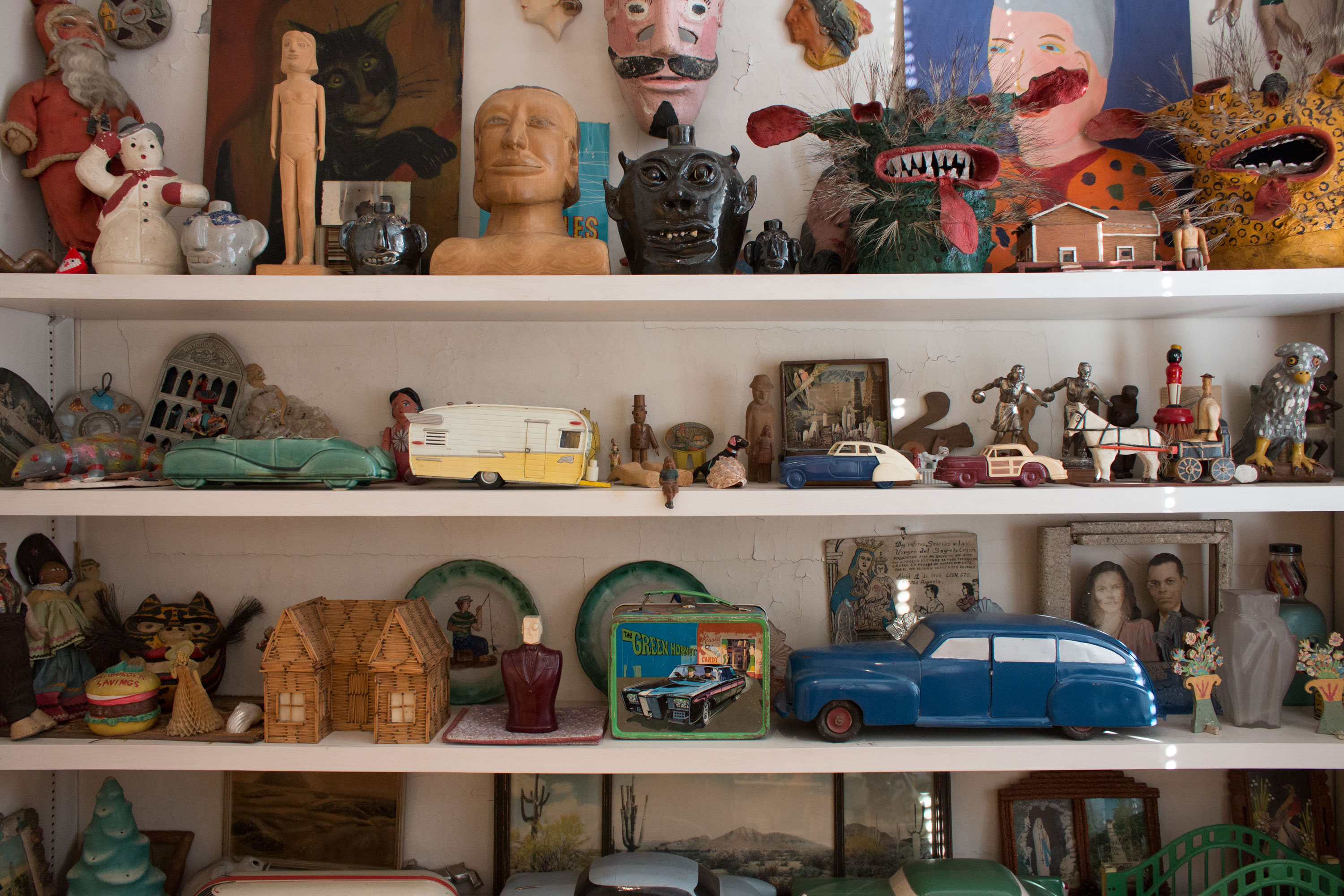
“Artists collect and choose to live with things for very different reasons than your normal person. Artists choose to live with things that are disturbing, that cause curiosity, or that are confusing,” said head curator Lisa Stone of the Roger Brown Study Collection (RBSC).
Roger Brown, an alumnus of the School of the Art Institute of Chicago (SAIC), left his art collection (and the house that contains it) to the school as a resource when he died in 1997.
The RBSC is a treasure-trove of artistic objects that often incite amazement and wonder; while some pieces Brown collected leave a lingering feeling of discomfort. The house, a great resource to students at SAIC, isn’t entirely known. Neither is the life of the artist behind the collection that donated both his four homes and his entire estate to the school. Brown is a name that is commonly thrown around with the other SAIC alumni and elites. Between the wealthy donors and alumni names that are thrown around on campus (think Flaxman, Maclean, Sharp, or LeRoy) it’s easy to get lost in the many names and resources that we have access to.
Brown was a student at SAIC from 1965 to 1970, completing both his undergraduate and graduate degrees at the school. Also attending the American Academy of Art before SAIC, he graduated in 1970 and saw seemingly instant success.
Brown was first exhibited by art dealer Phyllis Kind in 1971, beginning his association with the Chicago Imagists. By 1974, only four years out of his master’s degree, Brown purchased his studio and home on Halsted Street and began renovating it with his partner George Veronda.
Throughout Brown’s life, his artistic career prospered, and he came to own three home studios. In the two years leading up to his eventual death and also in his will, Brown donated his homes and estates to SAIC. His homes in New Buffalo, Michigan, La Conchita, California, and the one that houses his collection in Chicago were all under the ownership of SAIC until the institute sold the La Conchita home to establish a scholarship in Brown’s name. Faculty members can still use his New Buffalo home as a residency, while students can interact with his collection in the city.
The collection is essentially Brown’s home preserved as it was when he died. Scattered amongst his clean and kept house are many depictions of biblical figures (Brown was a devout Christian), works from his fellow Chicago Imagists, personal works, and pieces by unknown and self-trained artists. As he traveled often (he even won a travel grant upon his graduation from SAIC), many objects are foreign or indigenous. While the home is cluttered, it has a nice organization to it (thanks in large part to the curatorial staff).
Many students are unaware that this collection exists. Not only is it off the main campus in Lincoln Park, the collection isn’t really discussed outside of the curatorial or Contemporary Practice (CP) classrooms. Unless a professor brings up the collection in class, how can students know about this resource?
“The RBSC was never discussed in any of my CP classes. Although I had resourceful professors during the experience, none of them ever mentioned the RBSC,” said sophomore Hannah Cusimano. “I would consider myself to be mildly involved with the SAIC community. I am part of a couple of focus groups through the Wellness Center, and I attend quite a few school events each semester. I also work for the Media Center, so I feel like I would know about the collection, but I never did.”
Students who do interact with the collection often feel it’s worth the trip to Lincoln Park.
“I think his collection inspired me as far as a form of research, which was the motive for my class viewing the house,” said freshman Vivian Brockman. “At the time of my visit, I focused primarily on the possible psychological motivations and understanding the relationships of the genres of objects. I also was interested in the ideas of the value assigned to objects in the form of a collection or museum.” Brockman’s CP research course visited the collection last semester.
“A lot of other classes come here, but it’s certainly not school-wide,” said the collection’s curator Lisa Stone. “A ceramics class comes every fall; it’s called the Curious Intimate Object. They install their collection throughout the collection for critique. A performance class meets here throughout the semester and eventually performs in the space around their research gathered here.”
Many students don’t know who Brown actually was or whether or not his collection represents his life, work, and time at SAIC.
It’s worth noting that there are some questionable pieces that Brown collected and displayed in his home. Pieces of negrobilia are scattered around the home, as well as many previously mentioned indigenous objects. A tapestry hangs in the entryway that advertises a Chicago “freak show” where an audience could come gawk at the armless foreigners. These sensitive and often appropriative works scattered around can certainly bring discomfort to the students and visitors who use the collection.
“He definitely had some pieces that depicted people of color in an extremely offensive manner. Not that I think they should be removed from his collection; that would only attempt to ignore and erase the racism communities of color had and still have to endure,” said junior Zoe Kaplan, who remembers visiting the RBSC with her CP research course.
Popular opinion seems to reflect that the RBSC is a place with troubled objects. Faculty argues that through these objects SAIC students can learn and interact with the problematic and violent history of ethnic caricatures in America.
“There are many museums and institutions dedicated to the preservation of stereotypical imagery of Blacks in America, and the ability to study these items first-hand allows us to have access to the troubling history of our nation,” said Director of Student Affairs for Diversity and Inclusion Rashayla Brown. “Destroying them or pretending that they never happened wouldn’t do much to educate on these issues.”
The collection’s head curator, Lisa Stone, stood with Brown on the importance of preserving pieces even if they evoked discomfort. “There’s often the idea that these are things we should get rid of, we should bury, just annihilate. But that doesn’t make that history go away, but dealing with it leads to understanding,” she said.
Many wonder why Brown would collect these objects in the first place. When asked whether or not she thought Brown shared the beliefs of the creators or collectors of any of the racially charged works, Stone said, “No, not at all! But they are [racially insensitive] and we still have to deal with them. How and why he had them. So we have to be able to talk about what they mean in this place. … Brown as a southerner, from Alabama, grew up with all these objects that people just had around.” She added that “the fact that he has the object doesn’t mean he condones the message, but because [the objects] are really interesting on a number of gut levels.”
As an artist that was truly monumental in the advancement of Chicago LGBTQ artists and AIDS activism, his collection of appropriative and troubling works shows the lack of intersectionality he may have adhered to.
At his core, Brown both during his life and in his legacy represents a facet of the artistic past that many of us wish for. The average four-year SAIC student (if they graduate) will leave with almost $40,000 in student debt. As much as we wish to travel the world and study art history on our own travel fellowships, many of us won’t have the chance to collect relics in Egypt and Europe just as Brown did. Brown may not represent the average SAIC student in 2017, but his home and collection can build inspiration in the minds of young students. Harnessing the problematic aspects of his artistic collection is all part of that.







